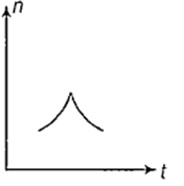 Multiple Choice Questions
Multiple Choice QuestionsThe equation of a transverse wave is given by , where x, y are in metre and t is in second. The minimum distance of separation between two particles which are in phase and the wave velocity are respectively
50 m, 50 ms-1
100 m, 100 ms-1
50 m, 100 ms-1
100 m, 50 ms-1
The frequency of the second overtone of the open pipe is equal to the frequency of the first overtone of the closed pipe. The ratio of the lengths of the open pipe and the closed pipe is
2 : 1
1 : 2
1 : 3
3 : 1
A person with vibrating tuning fork of frequency 338 Hz is moving towards a vertical wall with a speed of 2 ms-1 . Velocity of sound in air is 340 ms-1. The number of beats heard by that person per second is
2
4
6
8
A metallic wire of 1 m length has a mass of 10 x 10-3 kg. If a tension of 100 N is applied to a wire, what is the speed of transverse wave ?
100 ms-1
10 ms-1
200 ms-1
0.1 ms-1
A trainis approaching towards a platform with a speed of 10 ms-1 while blowing a whistle of frequency 340 Hz. What is the frequency of whistle heard by a stationary observer on the platform ? Given speed of sound = 340 ms-1.
330 Hz
350 Hz
340 Hz
360 Hz
When two tuning forks A and B are sounded together, 4 beats per second are heard. The frequency of the fork B is 348 Hz. When one of the prongs of the fork A is filled and sounded with B, the beat frequency increases, then the frequency of the fork A is
379 Hz
380 Hz
389 Hz
388 Hz
A source of sound is moving with a velocity of 50 ms-1 towards a stationary observer. The observer measures the frequency of sound as 500 Hz. The apparent frequency of sound as heard by the observer when source is moving away from him with the same speed is (Speed of sound at room temperature is 350 ms-1)
400 Hz
666 Hz
375 Hz
177.5 Hz
The waves set up in a closed pipe are
longitudinal and progressive
transverse and progressive
transverse and stationary
longitudinal and stationary
A racing car moving towards a cliff, sounds its horn. The driver observes that the sound reflected from the cliff has a pitch one octave higher than the actual sound of the horn. If v is the velocity of sound, then the velocity of the car is
v/2
v/4
v/3
D.
v/3
Let f be the frequency of horn emitted by car.
f' = observed frequency
Since, pitch ∝ f
∴ f' = f + f
One octave = frequency of instrument
vo = velocity of observer, let it be u
vs = velocity of source
Because here source and observer (car) both are same and moving with same velocity.
∴ vs = vo = u
v = velocity of sound
AB = source and sound are in same direction
Hence (v − u) = relatice velocity
BA = Observer and sound are in opposite direction hence
v + u = relative velocity
A railway engine whistling at a constant frequency moves with a constant speed. It goes past a stationary observer beside the railway track. Which of the following graphs best represent the variation of frequency of the sound n heard by the observer with the time t ?




